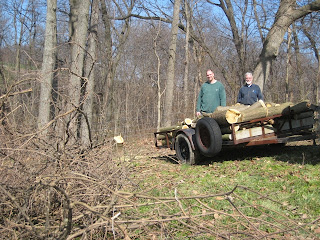In November, before the winter cold sets in, we "hill up" the vineyard, putting soil over the graft of each vine to protect it from winter damage. The grape hoe has a disk attachment for this purpose.
Pruning is done during the winter months. At this time we select and save three or four potential canes to be laid down on the fruiting wire in the spring. The other branches are pruned, pulled down off the wires, and placed between the rows to be chopped up with a flail mower and integrated back into the soil.
In early spring, as the vines become pliable, we select and lay down new canes on the fruiting wire, one each way from the trunk. These two photos show that process, however, these are young vines, so there is only one cane. The following year, canes will lay out in both directions, forming a "T".

When shoots start to grow from the canes, we thin them to about a hand's width apart. As they continue to grow, they are tucked between the catch wires and taped if necessary to maintain vertical growth. There are three sets of catch wires, about a foot apart, so tucking the growing vines is repeated several times during the spring and early summer. This picture shows the spacing of the catch wires.
In mid to late summer, the focus is on additional canopy management. Hedging keeps the tops trimmed to prevent them from hanging down over and shading the grape clusters.
We remove all lateral shoots that come off the main shoot. We remove leaves in the lower canopy to keep the fruit zone open to the sun.
 |
| Hedged, tucked, trimmed! |
Throughout the growing season we continue to use the grape hoe for weed control in the rows. Grass planted between the rows is mowed regularly as well.
Spraying the fruit is vital to prevent disease. The frequency for spraying is determined by the weather. We use a single row Lipco tunnel sprayer. This is an over-the-row sprayer which confines spray inside the tunnel and reclaims spray that isn't retained by the canopy. The reclaimed spray is filtered and returned to the tank, a 30% savings over air blast sprayers, saving not only money, but also reducing the amount of spray discharged into the environment.
 |
| Sprayer - front view |
 |
| Sprayer - rear view |
In mid to late July, we roll nets over the fruit to prevent bird damage. This year we also purchased a propane cannon to scare birds away from the vines. Bird control is a significant challenge. Many vineyards have said 2011 was one of the worst years experienced.
As you can see, canopy management is a labor intensive operation, made worthwhile by the joy of tasting great wine. You might also understand why a Schwab commercial pokes fun at vineyard development as a retirement hobby!
Next: Harvest!
Next: Harvest!

































